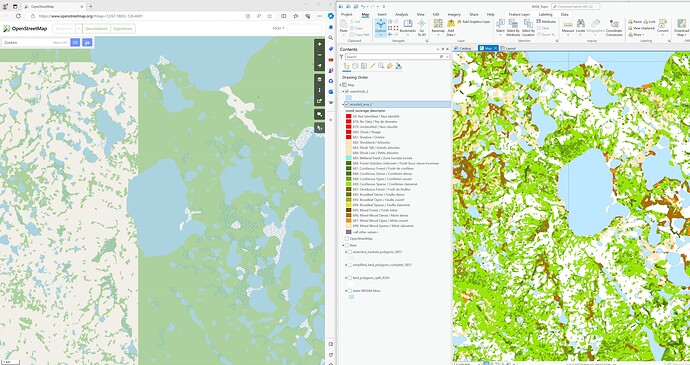Sorry for the catchy title, but I am actually highly surprised nobody has raised this issue in the Canada sub forum before.
Of course, the Canvec import has a long history in OSM, but over the past few months, a massive import of Canvec data has been taking place.
That by itself should not necessarily be an issue if done with due care - although in many similar cases it would have attracted quite a bit of attention and started discussions - but I would like to raise a particular issue regarding the current import:
There is a highly inconsistent and apparently broken import of “woodland / forest” type polygons taking place, that seems to be caused by the currently used import tools and processes. Polygons of neighboring Canvec tiles do not match in their forest cover. While some of that may be a “natural” consequence of different dates of production of the data by Natural Resources Canada, that is the main producer of the data if I am not mistaken, the differences are actually so big as to raise doubt on that as the main or real cause of the issues, pointing in the direction of the import processes themselves instead.
This appears to already have been an issue with the old Canvec imported many years ago looking at the map, but does not seem to have been fixed before deciding to continue importing Canvec “woodland / forest” data this year.
To investigate this issue a bit further, I downloaded official Canvec data in GIS format directly from the government’s website, and made the comparison visible below. As you can see, the two recently imported tiles in the left image, as taken from OpenStreetMap and showing an incongruent discontinuity between the tiles, seem to match perfectly in the actual data as visible in the right image as visualized in a GIS. This raises some serious doubts regarding the current import process.
Especially disturbing is the discontinuity between tiles of course, but there is the secondary and partly related issue of what actually constitutes a “forest”. Canvec has a very fine-grained classification for forests, but only the “Forest” and “Dense” classes seem to be what is generally considered “woodland/forest” in OpenStreetMap. Also reviewing satellite imagery as comparison, has shown me that the “Open” and “Sparse” classes are most wetland scrub with sparse trees, that can hardly classify as forest. The existing classifications also don’t seem to be handled consistently from tile-to-tile.
As a consequence, much of what is now displayed as one green huge “forest” in OpenStreetMap’s Canada coverage, in reality is a highly diversified and highly fractured forest cover, that is really poorly represented by the current import. There is essentially a huge over-representation of forest cover.
It seems that there are two problems here with the current Canvec import tool: 1) clearly topologically incorrect construction of “woodland / forest” polygons based on the underlying technical data leading to “tiles” being almost entirely turned into one giant forest polygon, and 2) likely misclassification and / or inconsistent usage of the existing forest classes for building “woodland / forest” polygons.
What do people in the Canada community think of the current situation, and what remedies could be employed?
